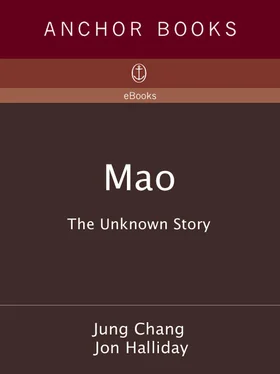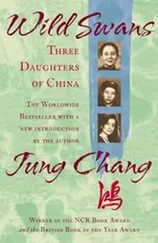In contrast, Kuo-tao’s army, 20,000 at the outset of their own march, had quadrupled to an impressive 80,000. They were well fed, well equipped with machine-guns and mortars and ample ammunition, and superbly trained.
It was thus from a position of considerable strength that Kuo-tao met his colleagues. He was “a tall, stately man about forty,” Otto Braun recalled, who “received us as a host would his guests. He behaved with great self-confidence, fully aware of his military superiority and administrative power … His cadres … controlled most of the area’s meager resources, which were essential for the care of tens of thousands of Red Army soldiers … He was every bit as ambitious as Mao …”
The moment had arrived when Kuo-tao had to be given a job, and he had an extremely strong case for being made head of either the Party or the army. Mao did not want him to have either. It was showdown time. Mao seemed to be at an overwhelming disadvantage, and yet he emerged from the link-up with Kuo-tao as the victor, thanks to the three political figures who had been with him and formed the core Party leadership, the Secretariat — Lo Fu, Chou En-lai and Po Ku.
As far as Lo Fu was concerned, he had no hope of holding on to his position as Party No. 1 without Mao. Moreover, when Mao had decided to drag the army off on a detour, Lo had given his consent rather than risk losing his newly won position. Chou En-lai had colluded with Mao all the way. The one who on the face of it might seem to have had the least to lose by switching sides was Po Ku, who had been elbowed out of his No. 1 position by Mao and Lo Fu. But he too was heavily compromised in the destruction of the army; he had put up no effective struggle on its behalf, and was now very much a broken man.
So, although there was now a chance to gang up with Kuo-tao and ditch Mao, the top men chose not to do so, out of personal interest. If they now blamed Mao for everything that had gone wrong, this was bound to raise the question: Where were you? This would imply that there had been a better alternative which they had failed to grasp. It would make them seem unfit to be leaders. Out of self-protection, they stuck with a simple story-line: that the Central Army had been wrecked by more powerful Nationalist forces. To bolster the image of their own resilience, they tried to denigrate Kuo-tao’s army, which had been highly successful, in spite of the heavy fighting it had faced. As they could hardly fault its military performance, they resorted to political smear tactics, saying it suffered from “warlordism” and “political backwardness,” and had “a bandit style.”
These accusations enraged Kuo-tao’s army. The two camps descended into a mud-slinging contest, in which Kuo-tao’s men had a virtual walkover. The wretched state of the Central Red Army was plain for all to see, and the scorn poured on it clung to the whole of the leadership.
“How can such a Centre and Mao Tse-tung lead us?” was the widely voiced sentiment. This resentment was directed against the entire Center, not just Mao, and this was a key factor in throwing the three core leaders — Lo Fu, Chou En-lai and Po Ku — together with Mao, which gave him a majority in the Secretariat of 4 to 1 against Kuo-tao.
The trio felt it was “sink or swim” with Mao as their own officers and soldiers started to vent their outrage as well. There was a flood of complaints about military “incompetence” and indifference to the welfare of the rank-and-file. “They didn’t know where they were running … so aimlessly,” officers told Kuo-tao, and “should have let the army rest and recover.” The rank-and-file, in turn, voiced bitter feelings about the way their leaders had abandoned the wounded, and turned ordinary soldiers into “sedan-chair bearers” for the VIPs and their wives.
This charge — that Mao and the other leaders had “sat in sedan chairs” all through the March — was the sorest issue of them all. A Long Marcher told us how angry the ordinary soldiers had felt: the leaders “talked about equality, but they lounged about in litters, like landlords. We talked in whispers …” The soldiers were told that “the leaders have a very hard life. Although they don’t walk, nor carry loads, their brains and everything have it much rougher than we do. We only walk and eat, we don’t have cares.” Not surprisingly, this low-level sophistry failed to assuage the rank-and-file.
Not having to walk made the difference between life and death. Not a single one of the wounded or the weak with a high enough rank to qualify for the Cadres’ Convalescent Company died on the March. Nor did any of the leaders who were carried, even those who were badly wounded. While the elite all survived, sheer exhaustion killed many of their much younger litter-carriers, nurses and bodyguards, who were often in their teens — and some as young as twelve or thirteen. One statistic reveals the stony-hearted hierarchy and privilege under Mao’s dominion: the Central Red Army now had almost more officers than soldiers.
WITH THE CONNIVANCE of his three Party allies, Mao offered Kuo-tao only the token position of deputy chairman of the Military Council, which was now a hollow shell, not even a rubber stamp. Kuo-tao and his subordinates demanded that he must lead the army. Mao responded with a stony silence. During the stand-off, the troops began to run out of food. The two armies, totaling about 90,000 men, were crowded into a Tibetan highland region that was just able to sustain its own population, but whose economy was completely thrown out of kilter by the advent of this huge force. “We were reduced to fighting for food with the local population,” one Red Army officer recalled. Marchers cut down fields of barley, depriving the locals of their livelihood for the coming year. Mao, characteristically, treated this plundering — which probably made the difference between life and death for many thousands — as a joke: “This is our only foreign debt,” he said to his American spokesman Edgar Snow, in a manner that Snow described as “humorous.”
The Tibetans, not surprisingly, hated the Reds. Excellent marksmen, they launched guerrilla attacks from the forests. Long March diaries recorded: “There were a lot of corpses along the way, mostly stragglers killed by the barbarians.” “Came across three stragglers (cut down by barbarian cavalry).”
In the end, Mao had to let Kuo-tao have the top army job. On 18 July, Kuo-tao was appointed Chief Commissar of the Red Army, “directly commanding all the armies.” But Mao kept control of the Party leadership.
AT THE BEGINNING of August 1935, a detailed plan was agreed for going north — in order, as Mao put it, to be “close to the Soviet Union, where we can receive help … planes and artillery.” The plan envisaged going first to Gansu, and then sending a unit on to Xinjiang, which was a Soviet satellite, “and building airports and arsenals.” It was during this operation to move north that Mao machinated to scupper Kuo-tao’s chances of making contact with the Russians before he himself did.
The agreed plan involved dividing the army: the main force under Kuo-tao and Zhu De would seize the town of Aba and then go on north, while a smaller force, known as the Right Column, was to take a different route farther east, via Banyou. By Mao’s choice, he and the Center went with the Right Column, which contained the bulk of his old troops, under Lin Biao and Peng De-huai, though these now answered to two of Kuo-tao’s commanders. Nine days after Kuo-tao and his force had departed, on 15 August, Mao cabled Kuo-tao in the name of the Politburo, dictating a total change of course: “the main force must go via Banyou,” i.e., follow the same route as the Right Column. Mao was thus tearing up the agreed plan and demanding that Kuo-tao and the many tens of thousands of troops in the other column reverse course and come to him.
Читать дальше










